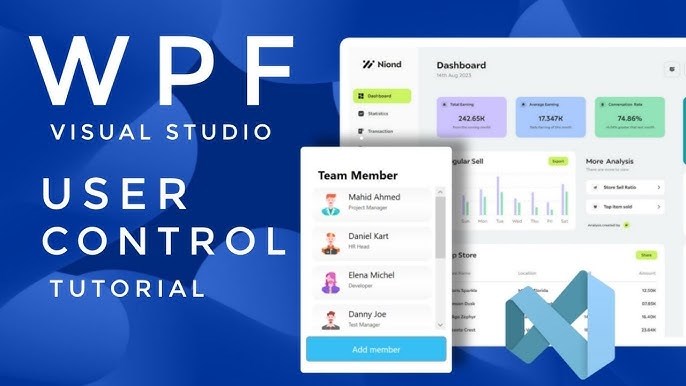Introduction to Windows Presentation Foundation (WPF)
Windows Presentation Foundation (WPF) is a UI framework developed by Microsoft that is part of the .NET ecosystem. First introduced with .NET Framework 3.0, WPF provides a rich platform for building modern, visually appealing, and highly interactive desktop applications for Windows.

Key Features of WPF
- Declarative Programming with XAML WPF leverages XAML (eXtensible Application Markup Language) to define user interfaces declaratively. This separation of UI design and logic allows designers and developers to work seamlessly.
- Data Binding and MVVM WPF's robust data binding capabilities, combined with the Model-View-ViewModel (MVVM) design pattern, enable the creation of maintainable and testable applications.
- Styles and Templates
- Styles: Define consistent appearance for controls across the application.
- Templates: Customize the structure and appearance of controls.
- Graphics and Animations WPF supports vector-based graphics, 2D and 3D rendering, and animations, making it ideal for applications requiring visually rich interfaces.
- Resolution Independence WPF uses device-independent units, ensuring consistent UI scaling across different screen resolutions and DPI settings.
- Integration with Windows WPF applications integrates tightly with Windows features like touch input, Windows Ink, and DirectX, providing enhanced functionality for modern devices.
- Event-driven programming WPF supports a wide range of event models, including routed events, enabling developers to handle user interactions effectively.
WPF Architecture
WPF is built on a layered architecture consisting of:
- PresentationFramework Provides high-level APIs for controls, styles, data binding, and more.
- PresentationCore Contains base types like UIElement and Visual that define the core functionality of WPF elements.
- MilCore The unmanaged layer responsible for rendering, utilizing DirectX for high-performance graphics.
- CLR and Managed Code The Common Language Runtime (CLR) underpins the entire WPF framework, ensuring language interoperability and runtime services.
Developing a Basic WPF Application
Here is a simple example to create a "Hello, WPF!" application:
XAML File (MainWindow.xaml):
<Window x:Class="WpfApp.MainWindow"
xmlns="http://schemas.microsoft.com/winfx/2006/xaml/presentation"
xmlns:x="http://schemas.microsoft.com/winfx/2006/xaml"
Title="Hello, WPF!" Height="200" Width="300">
<Grid>
<TextBlock HorizontalAlignment="Center" VerticalAlignment="Center" FontSize="20">
Welcome to WPF!
</TextBlock>
</Grid>
</Window>
Code-Behind File (MainWindow.xaml.cs):
using System.Windows;
namespace WpfApp
{
public partial class MainWindow : Window
{
public MainWindow()
{
InitializeComponent();
}
}
}
Advantages of WPF
- Rich User Experience WPF offers advanced styling and animation features to deliver compelling user interfaces.
- Separation of Concerns XAML and code-behind separation facilitate collaboration between designers and developers.
- Powerful Data Binding Supports complex data operations and real-time updates with minimal code.
- Flexibility and Extensibility Developers can create custom controls and extend existing controls to meet specific requirements.
Limitations of WPF
- Steep Learning Curve Mastering WPF and MVVM requires a significant time investment.
- Windows-Only WPF applications are limited to the Windows platform.
- Performance Concerns Inefficient use of resources in complex applications can lead to performance bottlenecks.

Conclusion
WPF is a powerful framework for building Windows desktop applications. Its combination of declarative programming, advanced graphics, and flexible architecture makes it a preferred choice for developers aiming to deliver modern and engaging user experiences. While it has its challenges, the benefits of WPF make it a valuable tool for .NET developers.
Whether you're creating a simple utility or a complex enterprise application, WPF provides the tools you need to succeed in crafting exceptional Windows desktop software.




Leave Comment